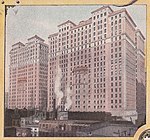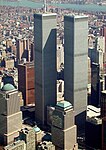The original World Trade Center (WTC) was a large complex of seven buildings in the Financial District of Lower Manhattan, New York City, United States. It opened on April 4, 1973, and was destroyed in 2001 during the September 11 attacks. At the time of their completion, the Twin Towers—the original 1 World Trade Center (the North Tower) at 1,368 feet (417 m); and 2 World Trade Center (the South Tower) at 1,362 feet (415.1 m)—were the tallest buildings in the world. Other buildings in the complex included the Marriott World Trade Center (3 WTC), 4 WTC, 5 WTC, 6 WTC, and 7 WTC. The complex contained 13,400,000 square feet (1,240,000 m2) of office space.
The core complex was built between 1966 and 1975, at a cost of $400 million (equivalent to $3.56 billion in 2022). The idea was suggested by David Rockefeller to help stimulate urban renewal in Lower Manhattan, and his brother Nelson signed the legislation to build it. The buildings at the complex were designed by Minoru Yamasaki. In 1998, the Port Authority of New York and New Jersey decided to privatize it by leasing the buildings to a private company to manage. It awarded the lease to Silverstein Properties in July 2001. During its existence, the World Trade Center symbolized globalization and the economic power of America. Although its design was initially criticized by New York citizens and professional critics, the Twin Towers became an icon of New York City. It had a major role in popular culture, and according to one estimate was depicted in 472 films. The Twin Towers were also used in Philippe Petit's frequent tightrope-walking performance on August 7, 1974. Following the September 11 attacks, mentions of the complex in various media were altered or deleted, and several dozen "memorial films" were created.The World Trade Center experienced several major crime and terrorist incidents, including a fire on February 13, 1975; a bombing on February 26, 1993; a bank robbery on January 14, 1998, and finally a terrorist attack on September 11, 2001. The latter began after Al-Qaeda-affiliated hijackers flew two Boeing 767 jets into the Twin Towers within minutes of each other. Between 16,400 and 18,000 people were in the Twin Towers when they were struck. The fires from the impacts were intensified by the planes’ burning jet fuel, which along with the initial damage to the buildings’ structural columns, ultimately caused both towers to collapse. The attacks in New York City killed 2,606 people in and within the vicinity of the towers, as well as all 157 on board the two aircraft. Falling debris from the towers, combined with fires that the debris initiated in several surrounding buildings, led to the partial or complete collapse of all the WTC complex's buildings including 7 World Trade Center, and caused catastrophic damage to 10 other large structures in the surrounding area.
The cleanup and recovery process at the World Trade Center site took eight months, during which the remains of the other buildings were demolished. On May 30, 2002, the last piece of WTC steel was ceremonially removed. A new World Trade Center complex is being built with six new skyscrapers and several other buildings, many of which are complete. A memorial and museum to those killed in the attacks, a new rapid transit hub, and an elevated park have been opened. The memorial features two square reflecting pools in the center marking where the Twin Towers stood. One World Trade Center, the tallest building in the Western Hemisphere at 1,776 feet (541 m) and the lead building for the new complex, was completed in May 2013 and opened in November 2014.










